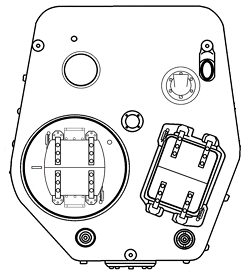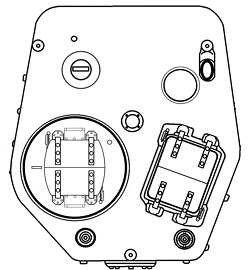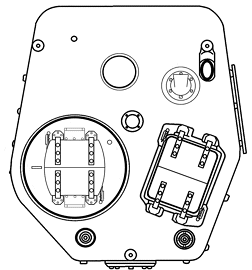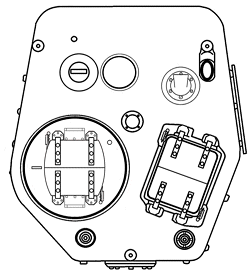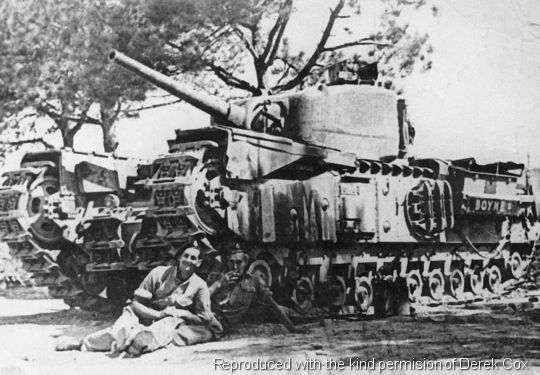
NA75 of the North Irish Horse, B Squadron, 1 Troop - Italy. |
The development of the Churchill NA 75 is attributable of the efforts and determination of one man, P.H. Morrell. Morrell had been Captain in command of a detachment of 665 Tank Troops and following the Fall of Tunis Morrell was attached to 16 Base Workshop R.E.M.E and employed in scrapping large numbers of battle casualty armoured vehicles accrued during the North African campaign.
Morrell in his article “Whitehot” makes the following comments on the Churchill which are key to understanding the motivations behind his development of the NA75:
“It was under-gunned - its 6-pdr, with an AP range of 800 yards and NIL HE performance, had proved to be no match for the 75 and 88mm guns of the hull down or dug in German tanks encountered during its advance up the Medjerda Valley.
In addition to being under-gunned, the gun mounting in the turret had an inside 'mantlet, the gun and co-axial Besa protruded through a large square hole in the front of the turret, the inside of the tank being protected by a slab of armour riding in slots and rising and falling as the gun was elevated and depressed. Although this arrangement afforded a degree of protection it was anything but impervious to machine gun 'splash’ and being situated some 8'~ behind the front face of the turret, in the bright light and shadow of North Africa, it showed up as a distinct black patch on the front of the turret. This patch was, for the German gunners, a convenient aiming mark, and is a fact that some 60% of the Churchill casualties in the Medjerda valley battles were hit on or around the mantlet.”
The Army Commander, and indeed many of the armoured formations preferred the more lightly armoured Sherman because of its 75mm gun with its range of 7,000 odd yards and an outside mantlet which cast no inconvenient shadow.
After the fall of Tunis, the two Churchill equipped Tank Brigades (25th Tank Brigade and 21st Tank Brigade) brigades were withdrawn to the area around Bone, where they were to stay for almost a year. Morrell believed this ‘enforced’ rest, whilst the 1st and 8th Armies invaded Sicily and Italy was due to “Montgomery having little use for a tank which had to approach so close to the enemy before it could inflict any damage, that the enemy gunners could wait literally until they could see the whites of its eyes, or at least the black patch on its turret, before picking it off at will.”
These comments by Morrell contain some rather subjective points:
The 6-pdr did have a HE round but the small calibre of the 6-pdr (57mm) ensured that the HE contained in the shell was only sufficient for the destruction of single upright targets, anti-tank guns etc and not for neutralising areas by concentration fire. The 75mm gun of the Sherman was a better dual purpose weapon havind adequate AP performance and a HE shell that was effective when targeting areas rather than individual targets.
The battle of the Medjerda Valley took a very heavy toll on the Churchills of 12 RTR and one can understand how, on seeing first hand the results of these battle casualties, Morrell thoughts might turn to finding inherent weaknesses in the Churchill design. However, the scale casualties encountered in the Medjerda Valley were due to tactical considerations and failings. There was no reconnaissance prior to the start of the battle, the artillery bombardment (the essential precursor to any attack in a wide open area such as the Valley) was minimal and the infantry and tanks became widely separated.
With regard to the internal mantlet of the Churchill there is no doubt that there was some concern about the resultant dark shadow providing an aiming point. However, Morrell’s observation of 60% of hits being in this area is probably to be expected as this represents the centre of the target. The Sherman being much taller would statistically probably take more hits in the hull.
There are a number of theories why the 21st and 25th Tank Brigades were not employed in the invasions of Sicily and Italy. Montgomery is said to have had a disliking not only for the Churchill but the 1st Army as a whole. It has also been suggested that the weight of the Churchill made it unsuitable for the bridges in Sicily.
Morrell noted that often the least damaged part of the scrapped tanks was the main armament, which in many cases, showed a useful remaining life of up to 85%. In light of his views on the effectiveness of the 6-pdr and the internal mantlet of the Churchill, Morrell considered the possibilities of adapting Churchill to take the Sherman 75mm gun. The Le Khroub tank park contained almost every current mark of Churchill and Sherman and so Morrell was in an ideal position to investigate further. Once convinced that it was at least a physical possibility, Morrell presented his ideas to D.D.M.E. who in turn immediately referred the matter to A.F.H.Q. Within a short period of time a civilian Vauxhall technical expert, John C. Jack (by coincidence and old acquaintance of Morrell’s), arrived at Le Khroub to assess Morrells proposals and report back. Jack’s subsequent report to D.D.M.E. confirmed that the Churchill turret would physically accommodate the Sherman 75mm gun, and that the turret ring and mounting of the Churchill was, if anything, stronger than that of the Sherman, and better able to withstand the shock of recoil. Twenty four hours after sending the report Jack and Morrell were summoned to A.F.H.Q. to meet with the D.M.E., Major General W.S. Tope, who was in overall command of all R.E.M.E. services in the Central Mediterranean theatre. Mager General Tope was, by all accounts, a blunt, direct, no nonsense engineer who did not suffer fools gladly. Tope grilled Morrell and Jack, both individually and together, until well into the evening going through every detail of the proposed modification. He produced detailed drawings of both Churchill and Sherman turrets, ballistics data on the gun specifications and technical data on the traverse, laying and firing mechanisms. Once convinced, Tope arranged with RAOC the release of a brand new Churchill Mk IV tank for trial modification. Morrell was granted permission to use such workshop facilities and personnel as were necessary but was instructed to concentrate his efforts to the fitting of the gun, and making it work properly. All questions of ammunition stowage etc. were to be held over until the gun and its functions have been proved. The project was given the code name 'Whitehot'. Major General Tope closed the interview by saying:
Modifications.
The first step was to remove the 6pdr together with its mantlet and auxiliary gear from the turret of a Mk.IV Churchill. The turret was then cleared and the internal guide ribs for the 6pdr mantlet removed. To accommodate the Sherman mantlet, a large aperture was cut in the front of the Churchill turret. Due to the curvature of the front of the cast Churchill turret it was necessary to rebate the cheeks on either side of the hole to accept the flat flange of the Sherman mantlet. When a satisfactory fit had been achieved the Sherman mantlet, complete with gun, was arc welded into position. This proved to be less straightforward than it sounds as the only arc welding equipment available for the prototype was the standard single operator workshop set, with the largest electrodes available being only 8 s.w.g. The work took therefore many hours of work and consumed some 400 electrodes!
The elevation limits of the gun posed an immediate problem. The mantlet and mount of the Sherman was designed to be set at an angle of some 30 degrees from the vertical. The gun barrel protruded through the mantlet with the elevation being limited by its movement in a slot. The effect of welding the mantlet to the vertical front face of the Churchill turret was to limit resultant maximum elevation to a little over the horizontal whilst permitting a much grater depression than was required. To compensate for this the top of the slot was extended by some 8" with the resulting cut out being welded back into the bottom of the slot. Internally a similar operation had to be performed on the toothed quadrant of the elevating gear, the top of which was carefully cut off, repositioned further around, and welded back with a strengthening gusset.
The majority of subsequent modifications required were due entirely to the different crew positions of the Churchill and the Sherman. In the American tank the driver sat to the left, the loader behind him and the gunner to the right with the tank commander behind him. The breech opening of the 75mm gun therefore faced to the left with the gun controls on the right. The Churchill was right hand drive, the crew positions were reversed and so armament was required to have a breech opening to the right with the gun laying controls to the left.
The Sherman gun mount consisted of a large boss mounted through the centre of which was a bore containing a phosphor bronze lined tube. The barrel of the gun slid up and down this tube as the gun recoiled and ran up. At the rear of the tube were extensions carrying cam tracks for the semi-automatic function of the gun, firing mechanism etc. Much thought was given to how to effect the rotation of the breech without requiring substantial reworking of the gun mount itself. Eventually Morrell himself came up with a solution by which only that portion of the gun mount which enclosed the breech would be rotated, leaving the main portion of the mounting as original. Such an operation ideally called for a large lath but with no such equipment available Morrell’s team were forced to improvise. The gun was removed from its tube, the rear end of which was then laboriously removed with a hacksaw. The edges of the cut were chiselled to a chamfer and the gun reinserted with the breech turned to the right, and the rear end of the tube turned through 180 degrees. The two parts of the tube were then stitched welded together, the gun barrel inside ensuring alignment. Once secure the gun barrel was again removed and join was arc welded.
The relocation of the gun controls to the left hand side proved to be relatively simple. The Sherman’s "periscopic’ site was initally fitted in a convenient circular hole into which was usually fitted the fume extractor which was relocated elsewhere.
|
Churchill MkIV |
NA75 |
A variation on this arrangment is show below.
|
Churchill MkIV |
NA75 |
In this case either the original MkIV turret had a central venitlator and new apperture has had to be fitted to mount the gun sight or the oringial MkIv turret was as above and a new ventilator apperture has been cut. Photographic evidence would appear to suggest the former. This arrangement may have been preferable to that above as in a report on the initial trials of the prototype NA75 criticised the ability of the ventilator to clear fumes from the turret. Having the ventilator mounted in the loaders periscope aperture as above would cause the fumes from the Besa to be drawn right across the turret to the loaders position. Using a central mounted ventilator would cure this problem and also with this arrangement the loader's sight is retained.
The elevating gear box was rotated in its mounting in order to raise the position of the hand-wheel shaft. An extension shaft was then mounted in a bracket welded to the turret roof enabling the hand wheel itself to be positioned near to the Gunner on the left. The firing controls for the Sherman gun were either a foot operated cable or electric solenoid and so were easily relocated.
The Sherman co-axial machine gun mounting was designed to take a Browning ·303" but when this gun was fitted into the modified Churchill it was found that at full elevation the butt grounded on the power traverse mechanism. The Browning mount was therefore modified so that it followed the main gun up until to the point where it grounded, at this point it then remained static whilst the main gun continued to its full elevation. Despite this limitation the degree of elevation was considered adequate. To standardise ammunition the hull Besa was also replaced by a Browning, an adapter bracket being devised to fit the Besa mounting.
Trials
The prototype took ten days to complete after which it was taken to the RAC Training Depot for firing trials. The were performed before the "top flight" of the armoured formations in North Africa, plus several flown in from Italy and elsewhere. The trials were conducted by Major ‘Dick’ Whittington’ a gunnery instructor at the school who also was one of Morrell’s friends. Once he had become accustomed to the gun Whittington was able to target a deserted Arab village at a range of some 8,000 to 8,500 yards, bringing down round after round of HE on top of it. Whittington subsequently commented that he found the Churchill a much more accurate gun platform than the Sherman as it did not 'rock' to the recoil of the gun to anything like the same extent.
The trials were a great success and immediate steps were taken to enable the conversion of further vehicles. The 665 Tank Troop Workshop was moved to Bone and attached to 16 Base Workshop R.E.M.E., where a large tank shop allocated specifically for the conversions. Work proceeded round the clock and in three months to June '44 some 190-200 conversions were produced.
Vehicle Characteristics
NA75s generally appear with applique arrmour applied to the hull sides. It also seems to have been general practice to remove the central section of the Track guards i.e that adjacent to the turret. In addition to the turret layouts shown above the photo of 'BOYNE' at the top of this article show what appears to be the early All Round Vision Cuppola.
Service
Upon arrival in Italy the 21st and 25th Tank Brigades were re-structured to include two troops (ie. 18) of Shermans in each Squadron. When the NA75s became available they essentially replaced the Shermans (only 3 or so retained). Within 25th Tank Brigade the North Irish Horse appear to have been the first to recieve NA75s - receiving a full complement of 18 in July 1944. The other two regiments in the brigade received theirs a few weeks later. At this time Vauxhalls were producing MkVIs and MkVIIs Churchills mounting the new QF 75mm, however priority for these vehicles was given to the new front in North West Europe. I've yet to come across any evidence of MkVIs in Italy and it would be until the end of November 1944 that the first few MkVIIs arrived with the Tank Brigades.
The NA75 stayed in service with the 25 Tank Brigade until the Brigade was disbanded in January 1945, and with 21 Tank brigade until the end of the war. Whilst we've noted the superior HE perfomance of the the Sheman 75mm it should also be noted that the 6-pdr had a better armour piercing performance coupled with a greater rate of fire. We should also realise that for the tank brigades in Italy at least, up until 1945 when MkVIIs started to be appear in numbers the highest proportion of tanks in the brigades were armed with 6-pdrs.
